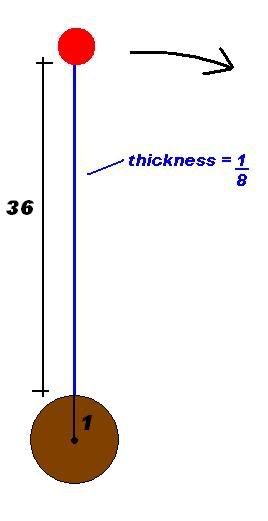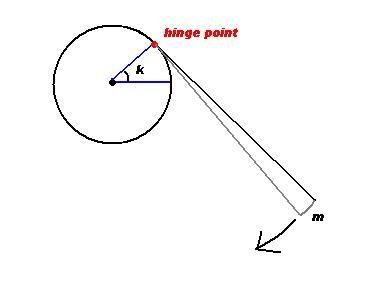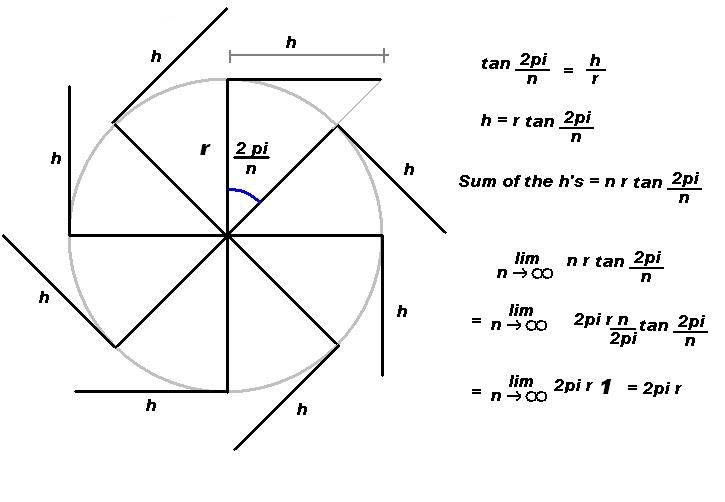Math Is Fun Forum
You are not logged in.
- Topics: Active | Unanswered
Pages: 1
#1 2006-04-30 08:09:20
- mikau
- Member

- Registered: 2005-08-22
- Posts: 1,504
tetherball
I think I just came up with one of the toughest math problems ever.
Say you have a 36 inch string 1/8 inches thick, attached to a ball at one end, and attached to a poll with a radius of 1 inch at the other, the ball starts at the position shown and begins to rotate about the poll. As the string wraps around the poll the string adds to the radius of the poll. How far does the ball travel before hitting the stick?

For the simplicity of the problem.
Assume the location of the ball is at the very tip of the string, and the ball itself does not get in the way when the very end of the string hits the poll.
Assume the growth of the radius of the stick is at a constant (a spiral) and does not simply increase by the thickness of the string only after the rotation is complete. Instead, assume that in half a rotation the radius has grown by half the thickness of the string, in 5/16 rotations, the radius has grown by 5/16 the thickness of the string and well you get the idea.
Also note, the ball will travel 90 degree's before the string even begins to wrap.
Last edited by mikau (2006-04-30 08:15:39)
A logarithm is just a misspelled algorithm.
Offline
#2 2006-04-30 08:34:40
- mikau
- Member

- Registered: 2005-08-22
- Posts: 1,504
Re: tetherball
I think the reason I'm having such difficulty trying to work this out is that you can't really find an angle to locate the ball from. Its not pivoting around the center of the poll and moving in, its pivoting around the edge of the poll its touching which is contstantly changing. So you really can't truely say its rotating around anything.
A logarithm is just a misspelled algorithm.
Offline
#3 2006-04-30 10:05:55
- mikau
- Member

- Registered: 2005-08-22
- Posts: 1,504
Re: tetherball
All right, this is getting interesting. It might be a good idea to define the angle as the point of tangency of the string to the poll, in relation to its center. At each exact point, the string will be hinging on the point of tangency which will be perpendicular to the radius at that point, and its path will be that of a circle rotating about the point of tangency.

So we write a formula to find arc m at each value of k, then find how many rotations is required to real the string all the way in (easy stuff)
but first I need to convince myself that this type of summaton will work. I'll explain in a minute.
Last edited by mikau (2006-04-30 10:10:48)
A logarithm is just a misspelled algorithm.
Offline
#4 2006-04-30 10:30:58
- mikau
- Member

- Registered: 2005-08-22
- Posts: 1,504
Re: tetherball
Its just that arc length is tricky. For instance you could use inscribed rectangles that look like a staircase to approximate the area under a curve, as the rectangles get smaller the area approximation gets closer, and the "staircase" looks more and more like the line. But if you try to find the length of the line by summing the horizontal and vertical faces of the steps your going to be way off. You need the pythagorean theorem to take into account movement in both dimensions.
In my summation system, finding an arc m at every point, we have to find the length of the string at that point, and rotate it an infinitsimal degree at the point of tangency, however, as the angle chances even by an infinitsimal, the point of rotation changes and the radius also changes. Do we need to take this ratio of change into account? Or will the infinitsimal difference in the radius and rotaton point tend to nothing? One thing calculus teaches us, is that an infinitsimal, times infinity does not always equal nothing.
A logarithm is just a misspelled algorithm.
Offline
#5 2006-04-30 11:14:17
- mikau
- Member

- Registered: 2005-08-22
- Posts: 1,504
Re: tetherball
The plot thickens..
Look at this little experment.

Say we divide a circle into n subsections, as shown. (illustrated as if n = 8) we then draw a radius to the edge of each subsection and then draw a perpendicular line at the point of tangency and extend it untill it intersects the path of the original radius. We know have n sides with a length of h where h/r = tan ( 2 pi /n ) if we sum all n sides we have n * tan ( 2 pi / n) (n * h)
If we take the limit as n approaches infinity, it ends up being 2 pi r which is what it would be if it were a circle. So the infinitsimal incorrect position of the line did not accumulate after an infinite summation and still remained at zero.
Ugh... it makes sense yet it doesn't make sense.
Last edited by mikau (2006-04-30 11:17:29)
A logarithm is just a misspelled algorithm.
Offline
#6 2006-04-30 12:18:00
- mikau
- Member

- Registered: 2005-08-22
- Posts: 1,504
Re: tetherball
Well assuming thats right, the answer should be about 380.2 inches. I need to see if I can write a program to approximate it using a reliable method.
(edit) whoops, messed up there, make that 543.226 inches. And I forgot to add the first quarter turn. But we don't need to worry about that much right now.
Well I finished a program and I think I got all the bugs out. It keeps giving me 542.667 but my formula gives me 543.226. Still I'm relying on the accuracy of the built in trig function of my C++ compiler and also the level of accuracy to which it can hold numbers.
Still, a difference of about 1.4 is enough to worry me.
I'm going to try writing a program to use numerical integration to find the area under one arch of cos x and compare it to the exact answer I get by integrating and see how much error there is.
(edit) did that and it came out pretty close. Either theres a minor bug or my formula is wrong. I suspect the latter. :-/
Last edited by mikau (2006-04-30 16:44:21)
A logarithm is just a misspelled algorithm.
Offline
#7 2006-05-01 05:53:26
- mikau
- Member

- Registered: 2005-08-22
- Posts: 1,504
Re: tetherball
Well I think I know where my mistake is. If I had found the objects exact direction of movement at a precise moment in time it would work. But the object isn't just hinging on the point of tangency, the radius is also changing and the hinging point is also changing. All the changes in movement must be taken into account to find its exact direction in a point in time. The reason it worked with the circle expermient was that we were going in the precise direction at each moment in time.
Well...back to the old drawing board. lol... well I'll keep thinking about it but this might be one of those problems that have no simple solution.
A logarithm is just a misspelled algorithm.
Offline
Pages: 1